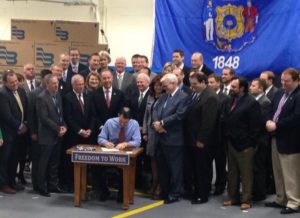
Wisconsin union membership stabilized in 2016, one year after experiencing the largest drop in the country, according to new data from the U.S. Bureau of Labor Statistics.
The state had 219,000 union members last year, representing 8.1 percent of the workforce. That was a slight drop from the 223,000 in unions in 2015. The decline amounted to a 1.8 percent drop. The decline was the smallest since 2008, the last year that union membership increased in the state.
Representation by unions also fell with 244,000 workers represented by unions, down from 253,000.
In 2015, the state’s union totals dropped by 83,000 or 27 percent. That was the same year Gov. Scott Walker signed legislation making Wisconsin a right-to-work state. The law prohibits businesses and unions from reaching labor agreements that require workers to pay union dues. Supporters said it allowed for worker freedom and made the state more attractive to business. Opponents argued the bill would destroy labor unions, lead to lower wages and endanger workplace safety.
A group of unions sued in 2015 to block the law and a Dane County judge ruled in April the law was unconstitutional, but that decision is on hold pending an appeal by the state.
Wisconsin’s change in union membership mirrored national totals which showed the number of members dropping by 1.6 percent to 14.6 million. Approximately 10.7 percent of workers were union members, compared with 11.1 percent in 2015.
The top five states for union membership included New York (23.6 percent), Hawaii (19.9), Alaska (18.5), Connecticut (17.5) and Washington (17.4). The bottom five states included South Carolina (1.6 percent), North Carolina (3), Arkansas (3.9), Georgia (3.9) and Texas (4).


